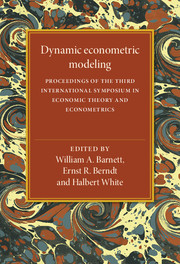 Dynamic Econometric Modeling
Dynamic Econometric Modeling Book contents
- Frontmatter
- Contents
- Editors' introduction
- List of contributors
- Part I Dynamic structural modeling
- Part II Linear time series modeling
- Part III Chaotic attractor modeling
- Part IV Applications
- 13 Investment and sales: some empirical evidence
- 14 Me and my shadow: estimating the size of the U.S. hidden economy from time series data
- 15 Estimating structural models of unemployment and job duration
13 - Investment and sales: some empirical evidence
Published online by Cambridge University Press: 03 May 2010
- Frontmatter
- Contents
- Editors' introduction
- List of contributors
- Part I Dynamic structural modeling
- Part II Linear time series modeling
- Part III Chaotic attractor modeling
- Part IV Applications
- 13 Investment and sales: some empirical evidence
- 14 Me and my shadow: estimating the size of the U.S. hidden economy from time series data
- 15 Estimating structural models of unemployment and job duration
Summary
This chapter attempts to give a structural interpretation to the distributed lag of sales on investment at the two–digit level in U.S. manufacturing. It first presents a simple model that captures the various sources of lags and their respective implications. It then estimates the model using both data on investment and sales as well as direct information on the sources of lags. The spirit of the chapter is exploratory; the model is used mainly as a vehicle to construct, present, and interpret the data.
Lags in the response of investment expenditures to sales can be attributed to four main sources. The first is expectations. Investment depends on future sales, which themselves depend on current and past sales. The next two come from technology. One, costs of adjustment, is internal to the firm. The other, delivery lags, is external to the firm. Together they imply that the firm is neither willing nor able to adjust its capital stock completely and instantaneously to movements in sales. The last source is financial. Although the theory describes investment orders, data are about investment expenditures, which are related to orders by a distributed lag. Section 1 presents a model that incorporates these four sources explicitly and shows their respective implications.
Section 2 presents the basic investment and sales characteristics for 13 industries. It estimates a reduced–form relation of investment on sales and the capital stock, showing common patterns and differences across industries.
Information
- Type
- Chapter
- Information
- Dynamic Econometric ModelingProceedings of the Third International Symposium in Economic Theory and Econometrics, pp. 269 - 296Publisher: Cambridge University PressPrint publication year: 1988
Accessibility standard: Unknown
Why this information is here
This section outlines the accessibility features of this content - including support for screen readers, full keyboard navigation and high-contrast display options. This may not be relevant for you.Accessibility Information
- 12
- Cited by